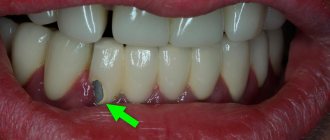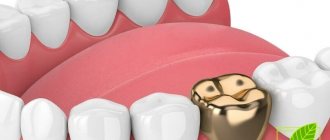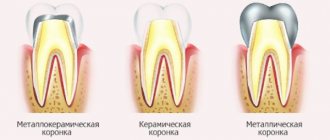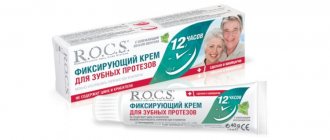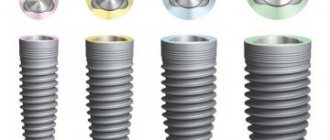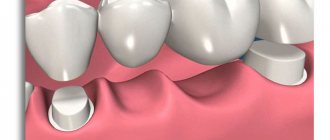Metal-ceramic crowns are a reliable, long-term way to restore teeth. Although cermet material is very durable, it is not eternal. The patient sometimes encounters cracks, abrasions, chips or scratches on the surface of the crown. Damage to ceramic cladding is caused by:
- High chewing load (too hard food);
- violation of the manufacturing technology of a crown or prosthesis;
- incompatibility of frame base and cladding materials;
- violation of installation technology (long prosthesis, incorrectly selected abutment teeth);
- bite problems;
- bruxism (teeth grinding).
Damage to the ceramic lining disrupts the aesthetics of the prosthetic structure and its functionality. But this is no reason to despair. The damaged surface can be restored, returning the crown to its original appearance. The main method of restoring a chipped crown without removing it is the restoration of metal ceramics with a light-curing composite.
Types of crowns
Metal-ceramic crowns differ in the metal alloy from which the frame is made, the manufacturing method, and service life. In most cases, an alloy of base metals (chromium-nickel, chromium-cobalt) is used to make the frame. They are durable, reliable, and not subject to deformation. This is a budget option that, with proper care, will last 8-10 years.
Often the frame is made of an alloy of gold with palladium, platinum, and silver. These are hypoallergenic materials that have an antibacterial effect, containing up to 80-90% gold. Ceramic-lined structures look natural, so they are perfect for installation in the smile area. Service life – up to 12-15 years.
When it comes to prosthetics on implants, the base of the crown is made of titanium. The material is compatible with body tissues, does not cause allergies, and eliminates the development of galvanic effect (galvanosis). Such structures will last 15 years or more.
According to manufacturing technology, metal-ceramic crowns can be cast or milled. Ceramic mass is applied layer by layer to the finished frame, made by any method, firing each subsequent layer. Modern dentistry has solved the problem of the “blue” strip around the gums, which made the installation of metal-ceramic structures on the front teeth undesirable. Today, crowns with shoulder mass are used - the manufacturing technology provides for a special ledge, which is also lined with ceramics to avoid oxidation of the metal upon contact with the gum. This makes the prosthesis aesthetic, allowing you to restore incisors and canines.
Stages of prosthetics
The process takes from 10 days to two weeks - from the moment the patient’s teeth are ground until the permanent crowns are installed. If an orthopedist offers to install crowns faster or the clinic announces a promotion for five-day prosthetics, you should not give in to the advertising and rush. Making a high-quality crown is not a quick process, and reducing the time required for prosthetics is almost always a guarantee of an unsatisfactory result.
Therapeutic tooth preparation
It is very important to carefully prepare the supporting tooth for wearing a crown, especially if the organ remains viable. First, the doctor examines it on an x-ray. If there are poorly filled root canals, a cyst is found on the apical part of the root, other abnormalities are noticeable - all this will need to be treated and refilled.
Pulpitis and periodontitis will also require preliminary therapy, including tooth depulpation: removal of the neurovascular bundle with filling of the root canals. Caries is treated completely, questionable fillings are replaced with new ones. Teeth with one root, even if they are completely healthy, are most often subject to depulpation - as already mentioned, during grinding the living pulp often dies. Multi-rooted chewing teeth do not undergo an expensive procedure in most cases - the thickness of the walls allows preparation to be carried out without harm to the nerve.
Sometimes severely damaged teeth are restored. If the walls of the organ are at least half preserved, it is possible to install a filling. You will first need to screw a reinforcing pin into the root canal and use a composite to recreate the missing part of the tooth to secure the crown.
If the visible part of the tooth is practically in ruins, the pin will not help. In this case, a stump or pin inlay is used. A metal-ceramic crown is then attached to it. This design will be durable and will not allow the tooth root to break under the chewing load.
Dental prosthetic procedure
- The treated and pulpless (according to indications) tooth is subjected to comprehensive grinding. The thickness of the removed tissue corresponds to the thickness of the walls of the prosthesis.
- The orthopedist makes an impression of the tooth stump and transfers the impression to the laboratory, where the dentist uses the impression to cast a mold, on the basis of which he then makes a metal-ceramic crown. The importance of adhering to standard deadlines in the production of a prosthesis has already been mentioned. At the same time, the large workload of masters shifts them towards increase. Such popularity of a laboratory usually indirectly indicates that it employs highly qualified specialists in their field.
- While the permanent crowns are being made, the dentist installs temporary dentures. This will require additional costs, but the measure is justified for many reasons:
- The prepared teeth are protected from accidental mechanical damage and from changes in the acidity of the oral environment.
- The aesthetics of the smile is preserved.
- If it is necessary to modify permanent structures - changing color, adjusting shape - the patient will not have to count the days waiting for final fixation.
- If it is not possible to install temporary crowns, ask your doctor to treat teeth prepared for prosthetics with a dentin-sealing liquid. The drug will be able to protect the exposed pulp.
Before deciding in favor of installing metal-ceramic crowns, it is recommended to do some mathematical calculations. The fact is that sometimes the cost of crowning one tooth - including treatment, pre-prosthetic preparation, creation of temporary structures - is comparable to the cost of installing an implant or exceeds it. It is even more worth considering if restoration of a single tooth in a row is required, and exclusively with a bridge prosthesis of three crowns. When installing such a bridge, you will have to grind down adjacent teeth, quite possibly completely intact ones. In the described situation, installing a high-quality single implant will preserve the health of neighboring teeth.
Restoration methods
Shallow cracks and abrasions are eliminated by polishing the ceramic surface. Small chips are restored using light-curing composites. This is the most common way to restore an orthopedic system without replacing it. Restoration of metal ceramics includes the following stages:
- The extension area is isolated from moisture;
- grind the chipped area to improve the adhesion of materials;
- after drying, a composite material is applied to the defect layer by layer, each layer is illuminated with a UV lamp;
- Upon completion of the extension, the area is ground and polished to give a natural shine, the appearance of a crown.
Repairing a metal-ceramic chip takes about 30 minutes. Restoration extends the life of the prosthesis, restores the original appearance, and returns the aesthetics and functionality of the dentition. However, repair of chips on metal ceramics is carried out without a guarantee, since there are many negative factors that affect the service life of the restoration.
If a metal-ceramic crown breaks off, there is no need to throw away the fragment. It is likely that the doctor will be able to use it to restore the integrity of the lining. In case of extensive damage, when a significant part of the metal is exposed, or chips of the lining of the contact surfaces, another option is required - replacing the damaged structure with a new one.
Reviews of metal-ceramic crowns
Metal-ceramic crowns cannot be perceived separately from the specialists who manufactured and installed them. It's just material in the hands of craftsmen, people who do their work professionally or carelessly. Therefore, it is worth critically evaluating negative reviews and meticulously choosing a clinic and orthopedist.
Frequent complaints from patients that are voiced on the Internet:
Low aesthetics . Often, even at the fitting stage, the patient notices that the crown has the wrong color, but for various reasons he prefers to remain silent. Sometimes the doctor also sees the difference, but if the patient remains silent, then the doctor does not enter into the discussion. Don't be afraid to express your wishes for correcting the shade. This will not require additional expenses from you at the specified time. But claims made after the final fixation of the crowns are satisfied at the expense of the patient.
Mismatch in tooth and crown sizes. This happens if the impression was made on the basis of a low-quality mass or when the impression was taken carelessly. The crown turns out to be too high, and it is difficult for the patient to close the teeth in the usual manner. Then the doctor, right before his eyes, begins to process the inside of the crown with a bur, grinding the frame to suitable dimensions. Sometimes even part of the ceramic coating is removed. As a result, the following happens: the prosthesis does not fit well to the tooth stump, and gaps remain. The tooth begins to rot and decay over time.
The tooth under the crown hurts. This is most often a consequence of poor-quality therapeutic preparation of the tooth before prosthetics; in most cases, x-rays show cysts and granulomas on poorly sealed root canals. It is necessary to treat the canals with the removal of the crown.
The crown broke off. The reason is the same as stated above – careless or unacceptable treatment of the tooth before restoration. For example, a doctor repaired a badly damaged tooth with a pin and a composite filling, but it was necessary to install a pin inlay and fix a crown to it. Due to the heavy load, the tooth root could not stand it if treated incorrectly and broke off.
Cracks and chips of ceramic coating. Occurs when the orthopedist does not monitor the closure of the crown or bridge and antagonist teeth. If there is excessive contact, grinding of the opposing teeth is required to soften the impact of closure. If the doctor neglects the mandatory procedure, the ceramics break off.
Sometimes it is not the doctor who is to blame, but the laboratory assistant who made the crown with irregularities when firing the layers of ceramic mass. The blame also lies with the patient himself, who tears bags with his teeth, chews hard nuts and seeds, and removes iron caps from bottles using his jaws. Repairing chips is possible without removing the crowns; the dentist will repair the defect in the person’s oral cavity, but these are unnecessary expenses that could have been avoided.
Installing a prosthesis is not a cheap pleasure. It’s better not to rush and have a consultation at several clinics, and then choose the one you like. If you are not satisfied with the quality of work, do not rush to sign any papers and do not hesitate to read even what is written in small print. Tell your doctor that you will sign the document after you have had crowns attached to temporary cement for 3-4 days. If no discomfort occurs during this time, then the product is in order.
How is a crown replaced?
Installation of a dental crown is a non-removable prosthetic method. This means that the patient cannot remove the structure on his own. This is done exclusively in a clinical setting. After the specialist has decided to replace the structure with a new one, in order to facilitate the removal of the damaged crown, it is carefully sawed or the cementing composition is destroyed with ultrasound. In this case, the crown can be removed without damaging it.
After removing the structure, the dentist assesses the condition of the supporting tooth and, if necessary, treats it. Upon completion of treatment and filling, repeated prosthetics are performed. That is, dental impressions are taken again, a prosthesis is made in the laboratory, and after fitting, the finished structure is fixed with cement.
The choice of material for a new dental crown depends on the clinical picture and the wishes of the patient. Often, when it is necessary to replace an old structure with a new one, the patient wants to improve the aesthetics by changing metal ceramics to solid ceramics or zirconium dioxide.
Area of special attention when installing metal-ceramic crowns
The dentist may not mention this during the consultation, but the patient should know that the appearance of metal-ceramic crowns varies. Crowns that look natural in one person's mouth may look completely foreign in another person's mouth. This happens for various reasons, one of which is the selected type of metal-ceramic prosthesis; we will list them below in the article.
A high-quality crown requires high-quality tooth preparation before installation. It is unacceptable to install long-term structures on untreated teeth, without a preliminary radiographic examination. When starting work, the dentist is obliged to examine the patient’s oral cavity: heal caries,, if necessary, depulpate the affected organ, and refill the canals. Control photographs after treatment must be taken.
The tooth for the crown is ground with a kind of ledge. This is also an indispensable factor for high-quality crown installation. But all the mentioned conditions, even if performed correctly, can be canceled out by poor-quality impression taking. If the doctor uses an obsolete plastic mass for an impression, then the crown will not reflect all the nuances of the soft and hard tissues around the tooth being prosthetized. Saliva will leak under a poorly fitting crown, food particles and bacterial plaque will begin to clog there. The tooth under the attachment will not stand and will begin to decay. The best masses for taking impressions: A-silicone, polyester mass.
Materials
In dentistry, the following are used to restore a tooth crown:
- Metal plastic, fragile structures. As a rule, they are used as temporary dentures or for implantation, if artificial teeth cannot be overloaded.
- Metal ceramics (metal base with ceramic coating). The likelihood of chipping on such crowns is lower than in the previous case, but with improper care, such structures can be destroyed.
- Ceramics. Under heavy load, structures can crumble and chips occur.
- Zirconium or aluminum dioxide. When using prosthetics with these crowns, the risk of various defects appearing during wear is minimized.
Metal ceramics
Metal ceramics represent a compromise between strength, aesthetics and cost. The structures are cast from metal alloys (mainly cobalt-nickel or cobalt-chromium) and can be either individual for each unit or pavement. In some cases, the frame may be made of titanium or precious materials.
A porcelain coating is applied over the metal body to match the patient's enamel color. The mass is applied manually, layer by layer, and during the manufacturing process, each layer is fired in an oven at high temperature. This technology is necessary to create additional strength of the product.
The disadvantage of metal-ceramics (as well as metal-plastic) is the need to grind down teeth and remove nerves to install a crown.
In addition, if the decorative layer is damaged, the metal base will be visible underneath it, which is significantly different from the appearance of other teeth.
This is interesting: Dental veneering - what is it: the main features of installing veneers, their types
Metal-plastic
Metal-plastic is made according to the same principle as metal-ceramics, with the difference that instead of porcelain, plastic acts as a facing material. It is cheaper than ceramics, but plastic has a number of disadvantages.
Plastic is capable of absorbing food particles during use, which can cause its surface to become stained and acquire an unpleasant odor.
In addition, the light transmittance of plastic differs from the enamel of real teeth much more than the same characteristic of porcelain, which reduces aesthetic indicators.
In addition, the problem of chipping decorative plastic coating is quite common.
Ceramics
Ceramic crowns are made from porcelain. They are created using high-temperature injection molding technology, which makes it possible to produce products of ideal shape and high strength.
Due to this technology, ceramic crowns do not require metal frames, although they are somewhat inferior in wear resistance to metal-ceramic structures.
Unlike metal-ceramics, porcelain crowns have a much more aesthetic appearance and stability.
The disadvantage of such products is the impossibility of manufacturing bridge structures (only individual dentures for the crown of teeth are made from ceramics). In addition, such products have a high cost.
Zirconium dioxide
Zirconium dioxide crowns are also ceramic-coated products. Zirconium dioxide is one of the most modern materials for the manufacture of dental crown prostheses.
The frame of zirconium crowns is very durable and has a natural color – white or close to the color of the patient’s enamel. A layer of sintered porcelain is applied on top of it.
This structure allows you to combine strength and high aesthetics. Zirconium crowns do not show through when exposed to direct color, which further increases their aesthetics.

